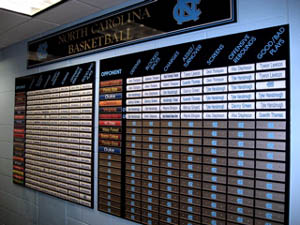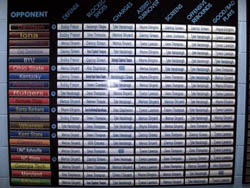  |
Last One Holding The Chalk...Usually Wins!(April 2008)Assortment of plays, drills and ideas to help your program improve.
Just finished looking over the new Dribble Motion Offense DVD everyone has been talking about. If you haven't heard, this is the offense that Memphis and Pepperdine have been using the past couple of seasons. I won't share with you the entire offense, as that would be unfair to the producers, but I will "peak your interest" with a couple of "specials" or "sets" out of the Dribble Motion alignment. You can purchase the complete DVD set from Syskos.com (with Herb Welling). You can also receive my new 118 page book in e-book form, "Implementing the Dribble Motion Offense" by purchasing a subscription to Scouting Hoops or making a purchase of over $50 in our Coaches Store. How to Get Your Athletes to Play Hard All the Time
Ever watch UNC men's basketball National Player of the Year candidate player Tyler Hansbrough play? You'll soon notice that he goes hard on EVERY play. He crashes the boards on EVERY shot. He pressures his player ALL over the court. He dives on the floor EVERY time there is a loose ball. He fights through screens on EVERY possession. Tyler has never taken a play or practice off in his three year career as a Tar Heel. Why does Tyler go so hard on EVERY possession? And, more importantly, how can you get your players to play as hard all the time?
The Carolina men's basketball program uses a unique charting system for practices and games that focuses on all the little things that need to be done to create a winning team. The charting system and accompanying Awards Board helps the players focus on the key processes of being successful and rewards those players who consistently contribute in a multitude of subtle yet important ways to the team's success. Carolina men's assistant basketball coach Jerod Haase recently shared with me the details of how the system works. So I am passing it along as an idea that you might be able to use or adapt with your program.
Usually within hours after the game, the entire staff sits down together to watch the film of the game. They examine each offensive and defensive possession in great detail. Defensively they record charges taken, deflections, boxouts, close outs, and a whole host of 37 subtle, yet important categories. Offensively they record the quality of screens a player sets, the times when a player loses the ball even when he doesn't turn it over, and tally passes that would have been assists had the player made the shot or was not fouled. All of these in-depth stats create a ratio of positive plays to negative plays. This ratio then is also one of the categories that Carolina uses to provide feedback to their players. The players are given the information at the next team meeting following the game. As Coach Haase said, "When we have an 9:00 pm game during the ACC tournament, sometimes we are up until 3:00 or 4:00 in the morning grading the tape, so that the players have the feedback the next morning at the team breakfast." Coach Williams wants the players to have the feedback when the game is still fresh in their minds. He fondly remembers a teacher he had growing up who always had the tests graded for them the next day of class - all in an effort to help the students effectively learn the material. He too feels he owes it to his players to provide them with timely feedback.
Coach Williams reads off the names of the players who were the winners for each of the categories. Then their names are listed on the Awards Board that is positioned right outside the locker room door in the Smith Center (see photo). Not only do the winners of the categories get acknowledged on the Awards Board, they also earn Plus Points, which they can use to get out of sprints at the end of practice. In talking with the Carolina coaches and players, they cite five primary benefits of the charting system and Awards board.
The system puts the focus on the process rather than the outcome of winning. The primary emphasis is on doing all the little things that make the outcomes of scoring and winning much more likely to happen.
Players take great pride in winning categories and seeing their names up on the board to appreciate their hard work. It does serve as a great incentive system, especially when they can also get out of sprints at the end of practice.
The charting system allows role players to get more attention and positive strokes for the key things they bring to the team. While the stars get all the accolades for the glamorous stats like points and rebounding, the role players get their due on the Awards Board for doing all the necessary dirty work like setting screens, taking charges, and diving on the floor for loose balls.
The credibility of the coaching staff is enhanced because the players see that they coaches are serious about the process of winning. They are willing to dedicate the time (sometimes in the wee hours of the morning) to meticulously break down the film and provide the players with key and timely feedback.
Finally, the charting system helps to more objectively quantify a player's contribution on the court. If someone has a dispute about playing time, the numbers are a great resource to help the player see why he isn't playing, and what specifically he needs to do to earn more time.
Think about it... What seemingly little, yet massively important subtle stats are you charting and rewarding for your team? Sit down with your coaching staff and make a list of all the little things you need your athletes to do that the casual fan might miss, but are vitally important to your team's success. Talk about their importance with your athletes and let them know that your staff/mangagers will be recording them in their upcoming competitions. You too can create an Awards Board to acknowledge and reward the winners of each category. It is a simple yet effective thing you can do to reward the behaviors you want to see repeated. And it is an effective way to encourage your players to go hard on EVERY possession. Remember, that which gets recorded and rewarded, often gets done and done well. |





